Overview

Cerebellum is the prominent hindbrain structure that is concerned with motor coordination, posture, balance, and some cognitive processes. It is composed of three layered cortex and deep nuclei, and attached to brain stem by the cerebellar penduncles.
Cerebellar Funtions
1. Cerebellum combines and coordinates rapid and skilled movements. 2. Controls and corrects compounds, complex movements through feedback and timing 3. Gains control through trial and error. established through error-correction or supervised learning network. 4. With time and practice control, passes from effortful to effortless 5. Effects on equilibrium, posture, and muscle tone.
Organization

The cerebellum is organized into an outer cortex of cells, deep nuclei ontaining output neurons and white matter fiber tracts along which inputs and outputs course. The cerebellum receives both ascending projections from the spinal cord and brainstem and descending projections originating in the frontal motor and parital cortices. Spinal cord inputs come mainly from muscle proprioceptors and convey information about ongoing muscular activity and the position of the joints in space directly to the medial portions of the cerebellar cortex.
Reference
Purves, Dale, "Principles of Cognitive Neuroscience", Sinauer Associates, Inc., 2008